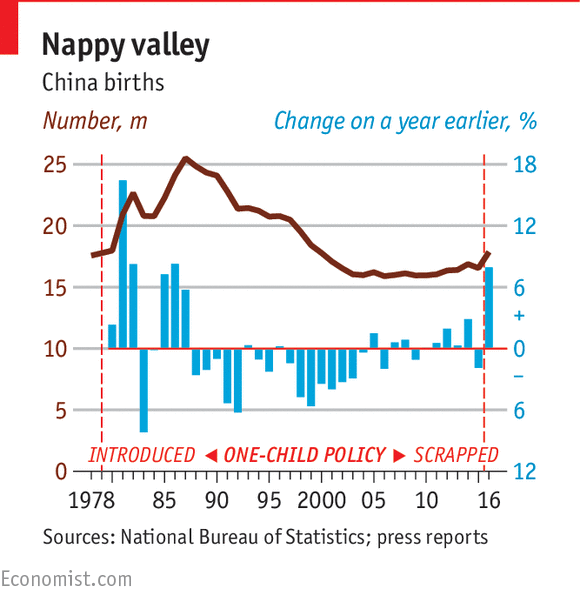Monkey business
All latest updatesWill it end the country’s fertility woes?

WHEN China’s government scrapped its one-child policy in 2015, allowing all couples to have a second child, officials pooh-poohed Western demographers’ fears that the relaxation was too little, too late. Rather, the government claimed, the new approach would start to reverse the country’s dramatic ageing. On January 22nd the National Health and Family Planning Commission revealed data that seemed to justify optimism: it said 18.5m babies had been born in Chinese hospitals in 2016. This was the highest number since 2000—an 11.5% increase over 2015. Of the new babies, 45% were second children, up from around 30% before 2013, suggesting the policy change had made a difference.

Confusingly, the National Bureau of Statistics announced its own figures at the same time: it said the number of births had risen by 8% to 17.9m (see chart). These numbers were based on a sample survey of the population, not hospital records, hence the difference. But both sets of figures used valid methods of calculating a birth rate and both showed a significant rise. Yang Wenzhuang of the health and family-planning agency said the increase showed the introduction of a two-child policy had come “in time and worked effectively”.
Alas, it is far too early to claim victory. There are several reasons for thinking the rise in births is a spike, and very few causes to believe the underlying fertility rate (the number of children a Chinese woman can expect to have during her lifetime) has risen much, if at all.
It always seemed likely that the one-child policy was a little like a dam, with couples wanting a second child banked up behind it. As soon as the flow of the dam was changed, they would have their desired babies quickly. That seems to have happened. It might also have made a difference that 2016 was the year of the monkey in the Chinese zodiacal calendar. This is considered a propitious year. Chinese couples have sometimes chosen to have a child under such a sign, rather than (say) in the less lucky year of the chicken, which begins on January 28th. So there were one-off reasons for the number of births to rise.
Even so, the increase was smaller than expected. When they introduced the two-child policy, family-planning officials forecast that between 17m and 20m babies would be born every year between 2015 and 2020—an increase of about 3m a year. In the event the increase in 2016 was only 1.3m. Moreover, if pent-up demand explains much of the increase, that influence will fade. After a brief spate, the flow of water through the dam will go back to what it was before—unless there is a change in China’s underlying fertility rate, meaning unless the average woman of child-bearing age decides she wants more children.
So far, that does not seem to be happening. It is true that the short-term rise in births may be hiding long-term changes but, anecdotally, there is little sign yet of a shift towards wanting larger families. More than 30 years of relentless propaganda have persuaded most Chinese that “one is enough”. In a government survey in 2015 three-quarters of couples said they did not want a second child, citing the cost of child care and education. People’s Daily, the Communist Party’s main mouthpiece, recently lamented that China’s fertility rate, at 1.05, was the lowest in the world (others put the rate a little higher). It has fallen consistently since 1950.
Even if the fertility rate were to rise, it might not be enough to offset the continuing influences of the one-child policy and the destruction of female fetuses that accompanied it. Because of these, the number of women of child-bearing age (15-49 years) is due to fall by about 5m each year in the next four years. So if the fertility rate stays the same, the number of births will start falling, because there will be fewer mothers to bear children.
And that in turn would mean the remorseless greying of China would continue. At the moment, one in seven of the population is over 60. By 2050, the share will rise to more than one-third. China will need more than a change in the one-child policy or a spike in the birth rate to reverse that.

No comments:
Post a Comment